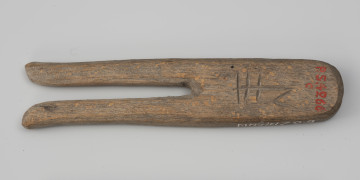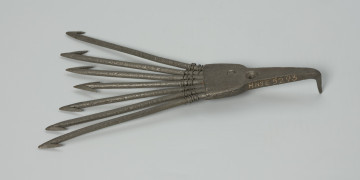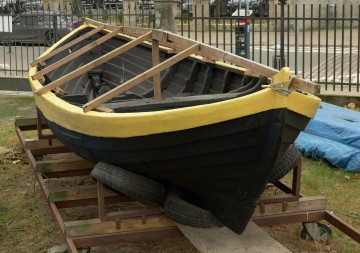
Buckle with ownership mark
1890 — 1950
National Museum in Szczecin
Part of the collection: Traditional fishing
Hand nets are simple tools, commonly used in traditional fishing for catching many species of fish. They can take different forms and sizes. The catching part of the tool is usually a bag-like net stretched over a wooden frame. The ethnographer Kazimierz Moszyński established that these tools derive from woven baskets, sacks and sheets. He distinguished three types of hand nets: handless, single-handed and double-handed. Hand nets were used in shallow inland waters, such as ponds and backwaters, often among rushes and bushes. A fisherman would wade through the water, dragging the net behind him by the bottom, scooping up the fish. Sometimes two people were involved in the process: one would walk in the front, scaring the fish and the other one would catch them to the net. Large hand nets were also used for fishing from a boat. In the fishing collection of the Department of Ethnography of the Pomerania of the National Museum in Szczecin there are six hand nets. One of them, coming from the first half of the 20th century is the presented single-handed hand net. It is a large cotton net, loosely stretched on a hoop, attached to a wooden handle. The tool was made from easily available raw materials, most likely for personal use, which was a common practice among fishermen. This hand net is one of the forty-four objects from the collection of the National Museum in Szczecin, coming from Nowe Warpno on the Szczecin Lagoon. It was purchased by the museum in 1949.
Agnieszka Słowińska
Author / creator
Dimensions
cały obiekt: height: 324 mm, width: 103 mm
Creation time / dating
Creation / finding place
Identification number
Location / status

1890 — 1950
National Museum in Szczecin

National Museum in Szczecin

1. połowa XX wieku
National Museum in Szczecin
DISCOVER this TOPIC
Museum of King Jan III's Palace at Wilanów
DISCOVER this PATH
Educational path